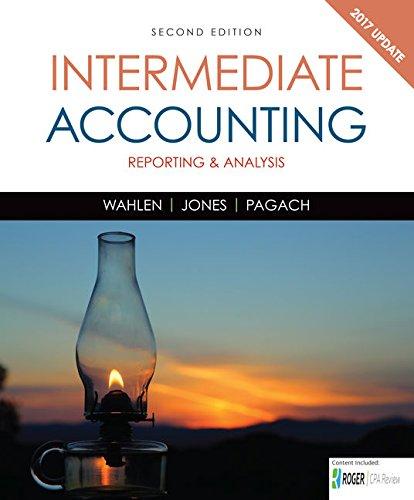
Cengagenowv2, 1 Term Printed Access Card For Wahlen/jones/pagach’s Intermediate Accounting: Reporting And Analysis, 2017 Update, 2nd
2nd Edition
ISBN: 9781337912259
Author: James M. Wahlen, Jefferson P. Jones, Donald Pagach
Publisher: Cengage Learning
expand_more
expand_more
format_list_bulleted
Question
Chapter 13, Problem 5P
To determine
Journalize the purchase of bonds, interest payment, partial sale of the investment on January 1, 2018, and the retirement of the bond issue on December 31, 2018.
Expert Solution & Answer
Want to see the full answer?
Check out a sample textbook solution
Students have asked these similar questions
??!!
Step by step solution
Net operating income
Chapter 13 Solutions
Cengagenowv2, 1 Term Printed Access Card For Wahlen/jones/pagach’s Intermediate Accounting: Reporting And Analysis, 2017 Update, 2nd
Ch. 13 - Prob. 1GICh. 13 - Provide brief definitions for the following terms:...Ch. 13 - Prob. 3GICh. 13 - Prob. 4GICh. 13 - Prob. 5GICh. 13 - Briefly summarize the accounting for an investment...Ch. 13 - Prob. 7GICh. 13 - Prob. 8GICh. 13 - Prob. 9GICh. 13 - Prob. 10GI
Ch. 13 - Prob. 11GICh. 13 - Prob. 12GICh. 13 - Prob. 13GICh. 13 - Prob. 14GICh. 13 - Briefly describe how to determine and record the...Ch. 13 - Prob. 16GICh. 13 - Prob. 17GICh. 13 - Prob. 18GICh. 13 - Prob. 19GICh. 13 - How does IFRS categorize minority passive...Ch. 13 - Prob. 21GICh. 13 - Prob. 22GICh. 13 - Prob. 23GICh. 13 - Prob. 24GICh. 13 - Prob. 25GICh. 13 - Prob. 26GICh. 13 - Prob. 27GICh. 13 - What is a fund? Distinguish between a fund and an...Ch. 13 - Prob. 29GICh. 13 - Prob. 30GICh. 13 - On January 1, 2016, Weaver Company purchased as...Ch. 13 - Prob. 2MCCh. 13 - Prob. 3MCCh. 13 - Prob. 4MCCh. 13 - Prob. 5MCCh. 13 - Prob. 6MCCh. 13 - A security in a portfolio of available-for-sale...Ch. 13 - Prob. 8MCCh. 13 - Cash dividends declared out of current earnings...Ch. 13 - Prob. 10MCCh. 13 - Prob. 1RECh. 13 - Prob. 2RECh. 13 - Prob. 3RECh. 13 - Prob. 4RECh. 13 - Prob. 5RECh. 13 - Prob. 6RECh. 13 - Prob. 7RECh. 13 - Prob. 8RECh. 13 - Prob. 9RECh. 13 - Prob. 10RECh. 13 - Prob. 11RECh. 13 - Prob. 12RECh. 13 - Prob. 13RECh. 13 - On January 1, Kilgore Inc. accepts a 20,000...Ch. 13 - Prob. 15RECh. 13 - Prob. 16RECh. 13 - Prob. 1ECh. 13 - Prob. 2ECh. 13 - Prob. 3ECh. 13 - Prob. 4ECh. 13 - Prob. 5ECh. 13 - Prob. 6ECh. 13 - Prob. 7ECh. 13 - Prob. 8ECh. 13 - Prob. 9ECh. 13 - Prob. 10ECh. 13 - Prob. 11ECh. 13 - Prob. 12ECh. 13 - Prob. 13ECh. 13 - Prob. 14ECh. 13 - Prob. 15ECh. 13 - Prob. 16ECh. 13 - Prob. 17ECh. 13 - Prob. 18ECh. 13 - Prob. 19ECh. 13 - Prob. 20ECh. 13 - Prob. 21ECh. 13 - Prob. 22ECh. 13 - Prob. 23ECh. 13 - Prob. 24ECh. 13 - Prob. 25ECh. 13 - Prob. 26ECh. 13 - Prob. 1PCh. 13 - Prob. 2PCh. 13 - Prob. 3PCh. 13 - Prob. 4PCh. 13 - Prob. 5PCh. 13 - Prob. 6PCh. 13 - Trading Securities 8th State Bank prepares interim...Ch. 13 - Available-for-Sale Securities Holly Company...Ch. 13 - Investments in Equity Securities Noonan...Ch. 13 - Available-for-Sale Investments Manson Incorporated...Ch. 13 - Prob. 11PCh. 13 - Prob. 12PCh. 13 - Prob. 13PCh. 13 - Prob. 14PCh. 13 - Prob. 15PCh. 13 - Prob. 16PCh. 13 - Prob. 17PCh. 13 - Prob. 18PCh. 13 - Prob. 19PCh. 13 - Prob. 20PCh. 13 - Prob. 21PCh. 13 - Prob. 22PCh. 13 - Prob. 23PCh. 13 - Prob. 1CCh. 13 - Investments in Securities Cane Company has two...Ch. 13 - Prob. 3CCh. 13 - Prob. 4CCh. 13 - Available-for-Sale Securities The following are...Ch. 13 - Prob. 6CCh. 13 - Prob. 7CCh. 13 - Prob. 8CCh. 13 - Prob. 9CCh. 13 - Prob. 10C
Knowledge Booster
Similar questions
- Please provide the correct answer to this general accounting problem using valid calculations.arrow_forwardExpert of accounts give ansarrow_forwardXavi Industries has two production departments with distributed production overhead of $15,000 for Dept. A and $9,000 for Dept. B. Dept. A uses a total of 6,000 labor hours, while Dept. B uses 3,000 labor hours. Assuming labor hours as the allocation base, what is the overhead rate for Dept. A? a. $2.50 b. $1.80 c. $3.00 d. $2.00 e. $2.75 MCQarrow_forward
- Please answer me fast expertarrow_forwardPlease explain the correct approach for solving this financial accounting question.arrow_forwardAn asset was purchased for $72,000 with a salvage value of $6,000 on July 1, Year 1. It has an estimated useful life of 6 years. Using the straight-line method, how much depreciation expense should be recognized on December 31, Year 1? I need Answerarrow_forward
arrow_back_ios
SEE MORE QUESTIONS
arrow_forward_ios
Recommended textbooks for you
 Intermediate Accounting: Reporting And AnalysisAccountingISBN:9781337788281Author:James M. Wahlen, Jefferson P. Jones, Donald PagachPublisher:Cengage Learning
Intermediate Accounting: Reporting And AnalysisAccountingISBN:9781337788281Author:James M. Wahlen, Jefferson P. Jones, Donald PagachPublisher:Cengage Learning Cornerstones of Financial AccountingAccountingISBN:9781337690881Author:Jay Rich, Jeff JonesPublisher:Cengage Learning
Cornerstones of Financial AccountingAccountingISBN:9781337690881Author:Jay Rich, Jeff JonesPublisher:Cengage Learning Financial Accounting: The Impact on Decision Make...AccountingISBN:9781305654174Author:Gary A. Porter, Curtis L. NortonPublisher:Cengage Learning
Financial Accounting: The Impact on Decision Make...AccountingISBN:9781305654174Author:Gary A. Porter, Curtis L. NortonPublisher:Cengage Learning College Accounting, Chapters 1-27AccountingISBN:9781337794756Author:HEINTZ, James A.Publisher:Cengage Learning,Principles of Accounting Volume 1AccountingISBN:9781947172685Author:OpenStaxPublisher:OpenStax College
College Accounting, Chapters 1-27AccountingISBN:9781337794756Author:HEINTZ, James A.Publisher:Cengage Learning,Principles of Accounting Volume 1AccountingISBN:9781947172685Author:OpenStaxPublisher:OpenStax College Financial AccountingAccountingISBN:9781305088436Author:Carl Warren, Jim Reeve, Jonathan DuchacPublisher:Cengage Learning
Financial AccountingAccountingISBN:9781305088436Author:Carl Warren, Jim Reeve, Jonathan DuchacPublisher:Cengage Learning

Intermediate Accounting: Reporting And Analysis
Accounting
ISBN:9781337788281
Author:James M. Wahlen, Jefferson P. Jones, Donald Pagach
Publisher:Cengage Learning

Cornerstones of Financial Accounting
Accounting
ISBN:9781337690881
Author:Jay Rich, Jeff Jones
Publisher:Cengage Learning

Financial Accounting: The Impact on Decision Make...
Accounting
ISBN:9781305654174
Author:Gary A. Porter, Curtis L. Norton
Publisher:Cengage Learning

College Accounting, Chapters 1-27
Accounting
ISBN:9781337794756
Author:HEINTZ, James A.
Publisher:Cengage Learning,

Principles of Accounting Volume 1
Accounting
ISBN:9781947172685
Author:OpenStax
Publisher:OpenStax College

Financial Accounting
Accounting
ISBN:9781305088436
Author:Carl Warren, Jim Reeve, Jonathan Duchac
Publisher:Cengage Learning